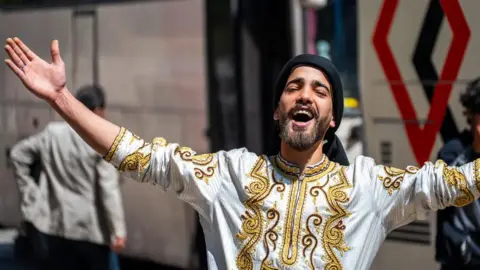The resounding echoes of jubilant music filled the air as Fatima Hazzouri celebrated her return home to Homs, Syria. After more than a decade of displacement due to the ravages of the civil war, she stepped off a bus, greeted by sunshine and the exuberance of musicians and dancers clad in traditional embroidered silk shirts. This moment marked a profound emotional milestone for Fatima and the 124 families returning with her, all of whom made the long journey from the north of Syria, where countless displaced people have sought refuge in makeshift shelters and tents.
This return isn’t just about triumph; it encapsulates the painfully complex landscape of post-war Homs, the city that bore witness to some of the most intense fighting between government and rebel forces. With the civil conflict spanning from 2011 and culminating in December 2024 with a rebel victory, the aftermath left an entire generation displaced. An estimated seven million Syrians were uprooted within the country, and an additional six million fled abroad. Over half of the nation’s population felt the dire impact of this upheaval.
The monumental challenge now lies in facilitating these returnees to settle back home in a city many times pulverized by conflict. President Donald Trump’s recent decision to lift U.S. sanctions on Syria has injected a new hope for reconstruction efforts; however, the reality on the ground reveals a starkly different picture. Many of those returning, like Fatima, find themselves without a brick-and-mortar home to return to, as her own residence was partially obliterated by rockets in 2012. This raises critical questions about how Syria’s governance can effectively mobilize resources to address the immense task of rebuilding amidst persistent scarcity.
In her excitement, Fatima expressed, “I’m overjoyed to be back,” signifying a complex mixture of euphoria and trepidation. While their convoy journey was exhausting, it was the thought of returning to their war-torn city that invigorated the families involved. Yet, as they arrive in Homs, the harsh reality sets in. Entire neighborhoods lay in ruins, and Homs continues to grapple with the constraints of inadequate services, including sporadic electricity.
Amidst this chaotic landscape, Fatima sought relief in the form of essential goods offered by a local charity. Meanwhile, her son-in-law, Abdulrazaq, had arrived ahead to ensure their possessions made it safely into an apartment they are renting while they plot how to repair their original dwelling. The daunting tasks ahead include fixing roofs and restoring basic amenities—projects requiring significant financial resources that many families, including Fatima’s, simply do not have.
The concerns extend beyond physical repairs. The war has left lasting economic scars, fostering systemic unemployment, and fueling uncertainty for families eager to find stable work. Khalifa al-Hakmi, an organizer of the returning convoy, highlighted the urgency of providing jobs for incoming families who have become accustomed to the threats of war and want to re-establish a sense of normalcy.
Furthermore, as the newly formed government, headed by the former Islamist rebel group Hayat Tahrir al-Sham (HTS), attempts to guide the nation toward recovery, they find themselves amidst myriad challenges, from ensuring vital services to navigating political intricacies involved in rebuilding a country decimated by years of violence.
With three million homes reported as non-inhabitable and an alarming 90% of the population currently living below the poverty line, the ops for rebuilding extend far beyond just physical infrastructure. Engaging the international community and strategizing on long-term recovery solutions is paramount. Current efforts to resettle refugees and mobilize necessary resources remain largely undeveloped.
As Fatima visited the remnants of her old home, she grappled with the reality that only two rooms remained livable and that undertaking repairs would necessitate thousands of dollars—puts into perspective both her resolve and the broader plight of those like her seeking to reshape their futures in a city enveloped in memories of both joy and sorrow. Today, however, even amidst such significant challenges, Fatima and others are determined to find meaning in their returns, for hopes of a revitalized Homs flicker amid the ruins, rekindled by the collective resilience of its people against the stark realities of their past.



